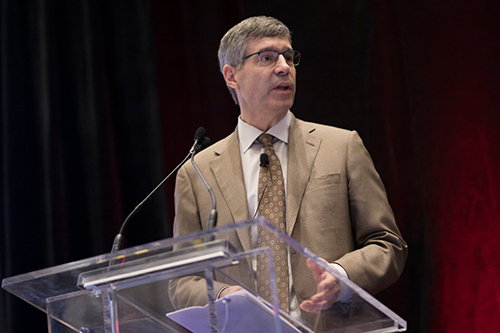
After reviewing, summarizing and translating more than 40 academic studies on cancer in the workplace, Chris Bonnett, principal consultant at H3 Consulting, found no lack of programs to address the issue.
“One of the key themes is that nobody needs another cancer program,” he told participants at Benefits Canada’s Employers Cancer Care Summit on Feb. 27 at the One King West hotel in Toronto.
Presenting a discussion paper on the gaps in workplace cancer management along with Allan Smofsky, managing director of Smofsky Strategic Planning, at the event, Bonnett said they tried to put the issues into the broader context of chronic disease management.
Read: A primer on the role of drug access navigators
“So it isn’t just about drugs, and it’s not just about disability, and it’s not just about occupational health and safety and environmental threats that can create a cancer risk in certain workplaces. It’s about all of that,” Bonnett told participants.
Bonnett highlighted the fact that cancer is very much a disease affecting working-age Canadians, with almost 90,000 new cases each year in that age bracket.
“I think one of the things we hope you’ll see is that this isn’t just a disease for the public sector and a disease for old age. It’s very much a condition of the workplace,” he said.
Bonnett went on to note that about 60 per cent of cancer survivors will return to work, with 40 per cent of that group needing workplace accommodation, such as adjustments to the hours or pace of work or having someone help them with manual labour. He also emphasized the need to deal with the issues individually. “It’s also important to think beyond the actual specifics of work, because the literature will tell you income and education levels are powerful predictors and correlated with return to work,” said Bonnett.
“Again, it can’t be one size fits all, because income levels vary, as do language skills, health and literacy. There are many different factors.”
Read: Options for supporting employees in the return to work
During his part of the presentation, Smofsky addressed the divide between workplace resources and the public health system and offered some suggestions for improvement.
Speaking about access to health benefits, Smofsky said the key is to provide adequate, but not necessarily perfect, coverage.
“We know we can’t cover everything all the time, but we have to look at the downstream impact of our decisions — whether that decision is to cover or not cover something, facilitate or restrict access — and I’m not just referring to drugs,” he said.
“So a good deal of the focus of our paper was to see, can we do a better job within the workplace space of organizing our resources once we know about the diagnosis? How we know will vary — an employer may not find out, but the insurer or [employee assistance program] might. The key lies in how do we better connect those workplace resources and, further, how can we connect those resources to the public health system? We’ve got to find a way to do that. Our suggestion is let’s do a better job in the workplace space and that may give us more talking points with public health system stakeholders,” he said.
“Really, what we’re saying is this is what we can start to do right now. And let’s start by looking at how we can best apply clinical, economic and humanistic principles in drug submissions, including workplace impact,” he added.
Read more coverage of the 2018 Employers Cancer Care Summit here
